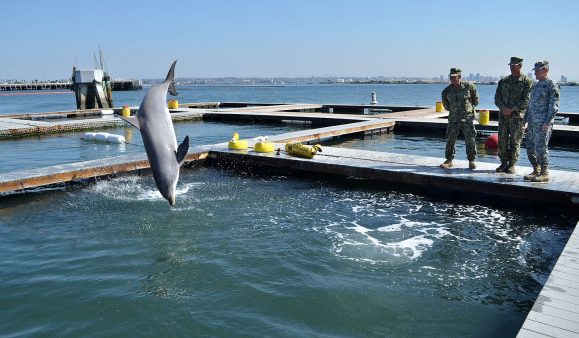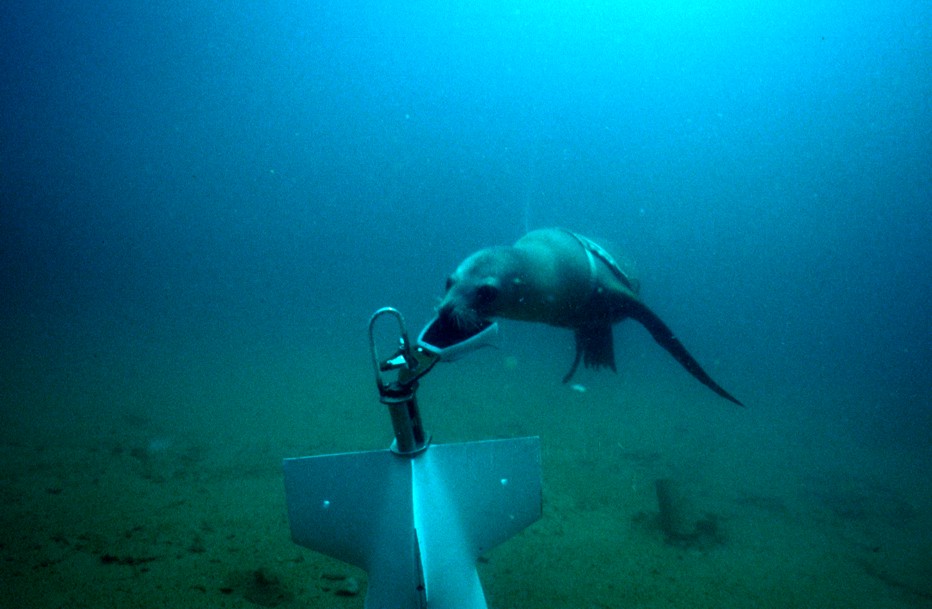Marine Mammals in the Military
5 June 2019
By Charlotte Gehrke
In April 2019, a beluga whale wearing a harness with a label reading ‘Equipment St. Petersberg’ was repeatedly spotted in Norwegian waters. This headline appeared only a few weeks after almost 100 beluga whales and orcas captured and held by a Russian fishery were released back into the wild. The whale, who has since been named ‘Whaledimir’ after an audience poll by Norwegian broadcaster NRK, sparked worldwide speculations of being a Russian ‘spy’. The tame animal was suspected to have been trained for military purposes, with some suggesting the option of camera equipment being tied to the harness. While these speculations may appear a bizarre twist on the “Arctic militarization” discourse of recent years, the history of marine mammals in the military is a long and fascinating one, as this short overview will illustrate.
From time immemorial, armies around the world have employed the use of somewhat domesticated animals, such as horses and dogs.1 During World War I, however, militaries began to turn to marine mammals. Most notable the British Royal Navy attempted to train sea lions to detect German submarines. However, these efforts failed as the animals would follow instructions in the training facilities, yet become distracted with hunting fish upon being released to the open ocean. But as training practices, veterinary care and husbandry techniques advanced, so did the military use of cetaceans. Eventually, both the US and Russia established their own marine mammal military programs.
Since 1959, the United States has fostered the Navy’s Marine Mammal Program (MMP). The MMP has reportedly trained and researched a great variety of marine mammals, including bottlenose dolphins (Tursiops truncates), California sea lions (Zalophus californianus), stellar sea lions (Eumatopias jubatus), belugas (Delphinapterus leucas), orcas (Orcinus orca), and pilot whales (Globocephalaspp.). The MMP eventually specialized on training bottlenose dolphins and California sea lions, as these are considered most suitable to the Navy’s missions due to their trainability, adaptability, and “heartiness”.

The MMP’s main facility is located at Point Loma in San Diego, holding approximately 80 dolphins and 30 sea lions. The program states its directive as training marine mammals to “detect, locate, mark and recover objects in harbors, coastal areas, and at depth in the open sea” (it is also explicitly stated that the animals are not “used as offensive weapons”). The animals are said to be trained through “positive reinforcement (correct responses are rewarded while incorrect responses are ignored)”. Since its inception, the MMP’s aquatic soldiers have been deployed in various locations around the globe, from Alaska and Australia to Iran, Bahrain and Vietnam.
While the US declassified the MMP’s missions in the 1990s, Russia’s marine mammal program remains somewhat covert. In the aftermath of Whaledimir’s recent sightings, satellite images of a covert Russian training facility for marine mammals on a pier in Olenya Bay on the Kola Peninsula were published.2 According to a declassified 1976 CIA report, Russia’s (resp. the Soviet Union’s) marine mammal program was inspired by Dr. John C. Lilly’s 1961 book Man and Dolphin. Dr. Lilly was a scientist known for his unorthodox research approaches, including the extensive use of hallucinogenic drugs on humans and cetacean test subjects alike. He believed that dolphins, intelligent creatures that they are, were attempting to communicate with humans and could be taught to speak English. Lilly’s theory has since been disproven by numerous studies, but experts maintain that the scientist was correct when it came to the dolphin’s remarkable intelligence. Nevertheless, the acknowledgements in the 1964 Russian translation of Dr. Lilly’s book, in which he thanked the Office of Naval Research (Department of Defense) for its help, led the Soviet government to assume “that the US Navy intended to use marine mammals to develop new weapons or to function as integral portions of weapons systems” and consequently begin a marine mammal training program of their own.3
However, while Russia and the US are generally noted to be the only the countries training marine mammals for military purposes, sales of these animals to other countries, including Iran, have been recorded, while the Ukraine led its own marine mammal program after the fall of the Soviet Union until its animals were ceased in 2014 with Russia’s annexation of Crimea.
Satellite images of Russia’s Arctic marine mammal training facility show a clear focus on Beluga whales and, to a lesser extent, seals, setting a contrast to the US Navy’s specialization on bottlenose dolphins and sea lions. The main reasons for this difference in marine mammals may be the purpose and hence area of operation that these mammals are being trained for by their respective militaries. While recorded US missions using marine mammals have been predominantly placed in warm waters, the location of the Russian facility and its focus on the Arctic native belugas, suggest interests in the water of the Circumpolar North. Ultimately, with thawing poles and growing economic and security interests in the Arctic region, these marine mammal programs seem likely to expand and become a familiar feature of Arctic security discourses.
[1] This distinction between horses and dogs, deemed somewhat domesticated, and marine mammals, which are considered wild animals (including those raised in captivity), is essential in condemning or advocating for such faunal military assistance, according to philosophers of animal ethics. However, animal rights activists, such as PETA (People for the Ethical Treatment of Animals), state that all animals, wild or domesticated, should not be implicated in warfare of any kind, as they are not able to have a choice in the matter.
[2] The peninsula is also considered to be “home to Russia’s secret special mission submarines”.
[3] These days, the US Navy’s MMP homepage includes the question “Why have there been so many rumors about the program?”, the answer to which still contains a reference to the film The Day of the Dolphin, an adaption of the French book Un animal doué de raison by Robert Merle, which was inspired by Dr. Lilly.
Extended list of sources available upon request.
Charlotte Gehrke is a student of journalism, communications and politics at Cardiff University. She also coordinates the Arctic Relations project, led by Dr. Hannes Hansen-Magnusson.
- From the Floe Edge: Visualising Sea Ice in Kinngait, Nunavut
- Bridging Knowledge and Action: A Polish-Norwegian Perspective on Arctic Science-Policy Collaboration
- Unpacking the Motivation Behind Wintering at Polar Stations
- Working the Ocean’s White Gold: A Nutshell History of a Living Bering Strait Tradition
- Political Participation in the Arctic: Who is heard, when, and how?